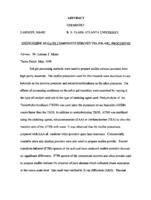- Collection:
- Atlanta University and Clark Atlanta University Theses and Dissertations
- Title:
- Oxide/oxide mijlltte composites derived via sol-gel processing, 1998
- Creator:
- Earnest, Shari P.
- Date of Original:
- 1998-05-01
- Subject:
- Degrees, Academic
Dissertations, Academic - Location:
- United States, Georgia, Fulton County, Atlanta, 33.749, -84.38798
- Medium:
- theses
- Type:
- Text
- Format:
- application/pdf
- Description:
- Sol-gel processing methods were used to prepare mullite ceramic powders from high purity materials. The mullite precursors used for this research were aluminum tri-sec butoxide as the alumina precursor and tetraethylorthosilicate as the silica precursor. The effects of processing conditions on the sol to gel transition were examined by varying i) the type of catalyst used and ii) the type of chelating agent used. Prehydrolysis of the Tetraethylorthosilicate (TEOS) was used since the aluminum tri-sec butoxide (ATSB) reacts faster than the TEOS. In addition to prehydrolyzing TEOS, ATSB was stabilized using the chelating agents, ethylacetoacetate (EAA) or triethanolamine (TEA) to slow the reaction rate of the ATSB with water. It was observed that the mullite precursors prepared with EAA all rendered white powders upon heat-treatment. Commercially available silica and alumina powders were also used to prepare mullite powder. Fourier transform infrared (FTIR) spectra of the acid and base catalyzed mullite powders showed no significant differences. FTIR spectra of the commercial alumina and silica powder used to prepare mullite indicate the presence of pure alumina which indicated phase separation at the micro-scale level. This result was verified by X-ray diffraction (XRD). Thermal gravimetric analysis (TGA) and differential thermal analysis (DTA) curves for both the acid and base catalyzed mullite precursor dried gels showed that mullitization occurs at approximately 1000C. XRD diffractograms of the acid and base catalyzed powders correlated well with the mullite reference pattern. Mullite fiber reinforced mullite composites were fabricated using the hot-press technique. Nextel 720 mullite fibers were used as the reinforcing fibers. Scanning electron microscopy (SEM) was used to examine a) the grain sizes of the mullite powders and mullite fiber reinforced composites, b) pinpoint fibers present in the mullite composite and c) the interfacial bonding between the mullite and the mullite fiber. In all cases, fine grain mullite powders were obtained prior to hot-pressing. As the powders were embedded with fibers and hot-pressed at higher temperatures, some of the grains of the powders fused together. At lower magnifications it was very difficult to pinpoint fibers in the matrix. As the magnification increased, fibers were seen distributed throughout the matrix; indicating good fiber/ matrix interaction in some regions of the sample. Due to hot-pressing conditions and preparation, it was difficult to determine exact grain sizes and fiber locations in the composites.
- External Identifiers:
- Metadata URL:
- http://hdl.handle.net/20.500.12322/cau.td:1998_earnest_shari_p.pdf
- Rights Holder:
- Clark Atlanta University
- Holding Institution:
- Atlanta University Center Robert W. Woodruff Library
- Rights:
-
